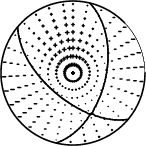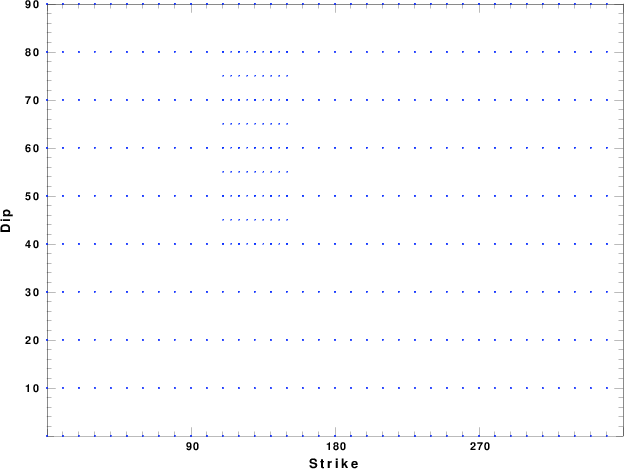
2013/05/22 17:19:39 35.299 -92.715 2.0 3.00
USGS Felt map for this earthquake
USGS/SLU Moment Tensor Solution
ENS 2013/05/22 17:19:39:0 35.30 -92.71 2.0 3.0
Stations used:
Filtering commands used:
hp c 0.02 n 3
lp c 0.10 n 3
Best Fitting Double Couple
Mo = 7.67e+20 dyne-cm
Mw = 3.19
Z = 8 km
Plane Strike Dip Rake
NP1 130 60 45
NP2 13 52 141
Principal Axes:
Axis Value Plunge Azimuth
T 7.67e+20 52 346
N 0.00e+00 38 157
P -7.67e+20 5 250
Moment Tensor: (dyne-cm)
Component Value
Mxx 1.87e+20
Mxy -3.13e+20
Mxz 3.82e+20
Myy -6.57e+20
Myz -3.34e+19
Mzz 4.70e+20
#############-
##################----
######################------
########################------
-############ ##########--------
--############ T ###########--------
----########### ###########---------
------########################----------
-------#######################----------
---------######################-----------
----------#####################-----------
-----------####################-----------
-------------#################------------
-----------###############-----------
P -------------############------------
---------------#########------------
-------------------#####------------
----------------------#-----------
-------------------###########
----------------############
-----------###########
----##########
Global CMT Convention Moment Tensor:
R T P
4.70e+20 3.82e+20 3.34e+19
3.82e+20 1.87e+20 3.13e+20
3.34e+19 3.13e+20 -6.57e+20
Details of the solution is found at
http://www.eas.slu.edu/eqc/eqc_mt/MECH.NA/20130522171939/index.html
|
STK = 130
DIP = 60
RAKE = 45
MW = 3.19
HS = 8.0
The waveform inversion is preferred.
The following compares this source inversion to others
USGS/SLU Moment Tensor Solution
ENS 2013/05/22 17:19:39:0 35.30 -92.71 2.0 3.0
Stations used:
Filtering commands used:
hp c 0.02 n 3
lp c 0.10 n 3
Best Fitting Double Couple
Mo = 7.67e+20 dyne-cm
Mw = 3.19
Z = 8 km
Plane Strike Dip Rake
NP1 130 60 45
NP2 13 52 141
Principal Axes:
Axis Value Plunge Azimuth
T 7.67e+20 52 346
N 0.00e+00 38 157
P -7.67e+20 5 250
Moment Tensor: (dyne-cm)
Component Value
Mxx 1.87e+20
Mxy -3.13e+20
Mxz 3.82e+20
Myy -6.57e+20
Myz -3.34e+19
Mzz 4.70e+20
#############-
##################----
######################------
########################------
-############ ##########--------
--############ T ###########--------
----########### ###########---------
------########################----------
-------#######################----------
---------######################-----------
----------#####################-----------
-----------####################-----------
-------------#################------------
-----------###############-----------
P -------------############------------
---------------#########------------
-------------------#####------------
----------------------#-----------
-------------------###########
----------------############
-----------###########
----##########
Global CMT Convention Moment Tensor:
R T P
4.70e+20 3.82e+20 3.34e+19
3.82e+20 1.87e+20 3.13e+20
3.34e+19 3.13e+20 -6.57e+20
Details of the solution is found at
http://www.eas.slu.edu/eqc/eqc_mt/MECH.NA/20130522171939/index.html
|
The focal mechanism was determined using broadband seismic waveforms. The location of the event and the and stations used for the waveform inversion are shown in the next figure.

|
|
|
The program wvfgrd96 was used with good traces observed at short distance to determine the focal mechanism, depth and seismic moment. This technique requires a high quality signal and well determined velocity model for the Green functions. To the extent that these are the quality data, this type of mechanism should be preferred over the radiation pattern technique which requires the separate step of defining the pressure and tension quadrants and the correct strike.
The observed and predicted traces are filtered using the following gsac commands:
hp c 0.02 n 3 lp c 0.10 n 3The results of this grid search from 0.5 to 19 km depth are as follow:
DEPTH STK DIP RAKE MW FIT
WVFGRD96 0.5 275 30 -45 3.12 0.0302
WVFGRD96 1.0 275 30 -45 3.17 0.0318
WVFGRD96 2.0 300 45 -45 3.20 0.0344
WVFGRD96 3.0 280 55 -50 3.20 0.0334
WVFGRD96 4.0 65 60 -95 3.22 0.0335
WVFGRD96 5.0 130 60 50 3.18 0.0352
WVFGRD96 6.0 130 55 50 3.19 0.0369
WVFGRD96 7.0 130 60 45 3.19 0.0378
WVFGRD96 8.0 130 60 45 3.19 0.0379
WVFGRD96 9.0 130 60 45 3.19 0.0377
WVFGRD96 10.0 125 65 45 3.21 0.0370
WVFGRD96 11.0 125 65 45 3.21 0.0365
WVFGRD96 12.0 175 45 25 3.23 0.0360
WVFGRD96 13.0 175 45 20 3.23 0.0356
WVFGRD96 14.0 165 45 0 3.23 0.0352
WVFGRD96 15.0 160 50 -10 3.25 0.0348
WVFGRD96 16.0 165 45 -30 3.25 0.0345
WVFGRD96 17.0 165 45 -30 3.26 0.0342
WVFGRD96 18.0 165 45 -35 3.27 0.0338
WVFGRD96 19.0 155 45 -40 3.28 0.0336
WVFGRD96 20.0 150 45 -40 3.31 0.0333
WVFGRD96 21.0 150 45 -40 3.32 0.0331
WVFGRD96 22.0 150 45 -40 3.32 0.0326
WVFGRD96 23.0 150 45 -40 3.33 0.0319
WVFGRD96 24.0 150 45 -40 3.34 0.0312
WVFGRD96 25.0 135 40 -40 3.35 0.0307
WVFGRD96 26.0 275 35 55 3.37 0.0309
WVFGRD96 27.0 275 35 50 3.38 0.0309
WVFGRD96 28.0 275 35 50 3.39 0.0309
WVFGRD96 29.0 275 35 50 3.39 0.0306
WVFGRD96 30.0 275 35 50 3.40 0.0301
WVFGRD96 31.0 100 65 70 3.36 0.0297
WVFGRD96 32.0 100 65 70 3.36 0.0296
WVFGRD96 33.0 110 65 80 3.38 0.0293
WVFGRD96 34.0 110 65 85 3.39 0.0290
WVFGRD96 35.0 110 65 85 3.39 0.0285
WVFGRD96 36.0 210 50 50 3.40 0.0285
WVFGRD96 37.0 210 50 50 3.41 0.0287
WVFGRD96 38.0 210 50 50 3.42 0.0289
WVFGRD96 39.0 210 50 50 3.43 0.0290
WVFGRD96 40.0 295 30 90 3.52 0.0286
WVFGRD96 41.0 290 30 85 3.53 0.0283
WVFGRD96 42.0 285 30 75 3.54 0.0279
WVFGRD96 43.0 285 30 75 3.55 0.0276
WVFGRD96 44.0 285 30 75 3.55 0.0273
WVFGRD96 45.0 285 30 75 3.56 0.0270
WVFGRD96 46.0 325 45 -40 3.51 0.0270
WVFGRD96 47.0 325 45 -40 3.52 0.0273
WVFGRD96 48.0 325 45 -40 3.52 0.0275
WVFGRD96 49.0 325 45 -40 3.53 0.0277
The best solution is
WVFGRD96 8.0 130 60 45 3.19 0.0379
The mechanism correspond to the best fit is

|
|
|
The best fit as a function of depth is given in the following figure:

|
|
|
The comparison of the observed and predicted waveforms is given in the next figure. The red traces are the observed and the blue are the predicted. Each observed-predicted component is plotted to the same scale and peak amplitudes are indicated by the numbers to the left of each trace. A pair of numbers is given in black at the right of each predicted traces. The upper number it the time shift required for maximum correlation between the observed and predicted traces. This time shift is required because the synthetics are not computed at exactly the same distance as the observed and because the velocity model used in the predictions may not be perfect. A positive time shift indicates that the prediction is too fast and should be delayed to match the observed trace (shift to the right in this figure). A negative value indicates that the prediction is too slow. The lower number gives the percentage of variance reduction to characterize the individual goodness of fit (100% indicates a perfect fit).
The bandpass filter used in the processing and for the display was
hp c 0.02 n 3 lp c 0.10 n 3

|
|
|

|
| Focal mechanism sensitivity at the preferred depth. The red color indicates a very good fit to thewavefroms. Each solution is plotted as a vector at a given value of strike and dip with the angle of the vector representing the rake angle, measured, with respect to the upward vertical (N) in the figure. |
A check on the assumed source location is possible by looking at the time shifts between the observed and predicted traces. The time shifts for waveform matching arise for several reasons:
Time_shift = A + B cos Azimuth + C Sin Azimuth
The time shifts for this inversion lead to the next figure:

The derived shift in origin time and epicentral coordinates are given at the bottom of the figure.
The CUS model used for the waveform synthetic seismograms and for the surface wave eigenfunctions and dispersion is as follows:
MODEL.01 CUS Model with Q from simple gamma values ISOTROPIC KGS FLAT EARTH 1-D CONSTANT VELOCITY LINE08 LINE09 LINE10 LINE11 H(KM) VP(KM/S) VS(KM/S) RHO(GM/CC) QP QS ETAP ETAS FREFP FREFS 1.0000 5.0000 2.8900 2.5000 0.172E-02 0.387E-02 0.00 0.00 1.00 1.00 9.0000 6.1000 3.5200 2.7300 0.160E-02 0.363E-02 0.00 0.00 1.00 1.00 10.0000 6.4000 3.7000 2.8200 0.149E-02 0.336E-02 0.00 0.00 1.00 1.00 20.0000 6.7000 3.8700 2.9020 0.000E-04 0.000E-04 0.00 0.00 1.00 1.00 0.0000 8.1500 4.7000 3.3640 0.194E-02 0.431E-02 0.00 0.00 1.00 1.00
Here we tabulate the reasons for not using certain digital data sets
The following stations did not have a valid response files: